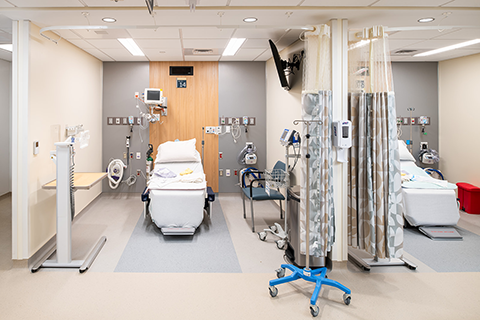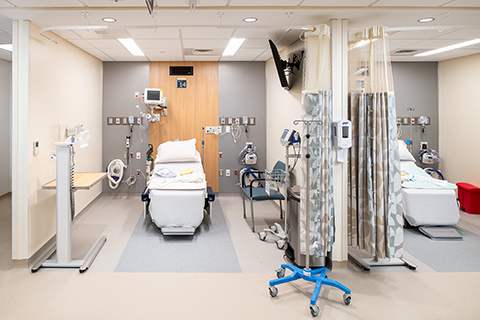- Who We Are
-
Our Work
-
Educational
- Brooks School- George and Evanthea Demoulas Family Boathouse
- Riverbend School - Gym and Schoolhouse
- Lesley University- Animation Studio
- Middlesex School- Bass Arts Pavilion and Danoff Visual Arts Center
- Nashoba Brooks School- Sureau Family Discovery Barn
- The Southport School- Arts and Music Building
- Senior Living
- Hospitality
-
Healthcare
- Partners Urgent Care
- Yale New Haven Health- Medical Office Building
- The Hospital of Central Connecticut - Advanced Wound and Hyperbaric Medicine Center
- Connecticut Children's - Infusion Center and Gastrointestinal Clinic
- Connecticut Children's - Specialty Care Center
- MidState Medical Center- Post-Anesthesia Care Unit Expansion & Renovation
- Commercial
- Specialty Work
-
Educational
- How We Do It
- Our Blog
- Industry Tidbits
- Join Our Family
- Contact Us
Occupied Healthcare Construction: Considerations When Hiring Your Contractor
October 16th, 2023
Healthcare construction needs to be seamless, because people’s lives are literally at stake. Patient safety is always the number one priority. When it comes to healthcare facilities, every detail matters, and the construction process can negatively impact patient care. When you hire your contractor, you want to look for one who communicates effectively, pre-plans the work, and minimizes disruption to your operations.
Effective Communication 
Effective communication is the cornerstone of any successful construction project. Communication is more than just talking and listening; it’s about making sure everyone involved is on the same page.
Healthcare construction involves many stakeholders, from architects and contractors to medical professionals and hospital staff. Clear communication ensures that everyone understands their roles and responsibilities, reducing the risk of misunderstanding and errors. When possible we use your preferred vendors. They’re used to working in your space and know your facility’s protocol. On a recent project, we learned that it can be worth it for you to pay a little more in order for us to hire a preferred vendor after we had to replace a subcontractor early on in the project.
To foster collaboration, it’s essential for the contractor to over-communicate with staff, doctors, and nurses. Your workers need to know what to expect regarding noise levels and distractions on a daily basis. The contractor should also build strong relationships with the healthcare team to help create a harmonious working environment.
Trust is paramount in healthcare construction. Open and transparent communication builds trust among all parties involved. Trust enables better decision-making and problem-solving, which are critical for a complex project like one in a healthcare setting.
Pre-planning the Work
Pre-planning, preconstruction meetings, and coordination sessions are critical for aligning the efforts of trade partners, the design team, the owner, and the facilities group. These meetings lay the groundwork for a well-organized construction process. It was through coordination meetings with the above-mentioned subcontractor that we learned they weren’t the right fit for the project. We were able to pivot to a preferred vendor without a negative impact to the schedule because we were planning the work early.
Pre-planning involves meticulous consideration of logistics, shutdowns, and critical aspects of the project. Other vital components to address include your expectations and requirements for third-party inspections, frequent communication of the contractor’s schedule with all relevant parties, and early resolution of the contractor’s questions. Getting the contractor in to conduct early surveys of the space and systems also ensures a smoother construction process.
Developing a comprehensive pre-planning strategy is key. It should encompass all aspects of the project, from timelines and budgets to safety protocols and risk mitigation plans. A well-thought-out strategy sets the course for a successful construction project.
Minimizing Disruption 
Healthcare construction can easily be disruptive, but there are measures to minimize it.
Healthcare construction teams must adhere to ICRA and ISLM plans in occupied facilities. These plans are designed to mitigate risks that could endanger patients, residents, and staff. The construction team must keep non-work areas clean to prevent infection risks. Using tools like STARC panels, negative air machines, and damp mats can help maintain a sterile environment outside the construction zone. Discussions with the healthcare facilities staff about building layout, traffic flows, parking, and debris disposal should be ongoing.
Your contractor should have clear notification protocols in place to alert healthcare staff before starting noisy work. This allows the staff to take necessary precautions and plan accordingly. For example, our superintendent would notify the hospital staff of noisy work before we started for the day. Once the loud activities began, he would do a quick check-in with the neighboring staff to make sure the noise was tolerable. If it was too loud to continue work, we would reschedule that activity to a night shift when it was less likely to disrupt the patient experience and healthcare operations. This was the case when we needed to demo a CMU vault that shared a wall with an active nurse’s station. As soon as we learned the work was too disruptive, we stopped and rescheduled it to the night shift team. Having a construction team that can adapt is critical.
In conclusion, the seamless construction of healthcare facilities requires open communication, meticulous planning, and a commitment to patient safety. By prioritizing these aspects, construction teams can ensure that healthcare facilities are built and renovated with the utmost care and precision, ultimately benefiting patients and the healthcare community as a whole. Politeness and professionalism go a long way when working in an occupied healthcare building. Building positive relationships with your hospital staff fosters a collaborative atmosphere.
Contact us to learn how we can help you with your next construction project.










